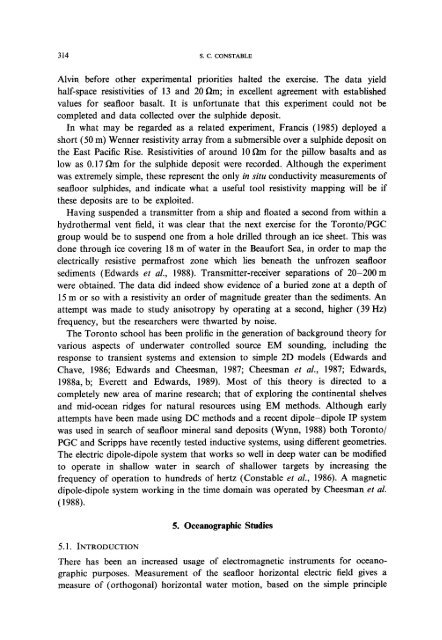Marine electromagnetic induction studies - Marine EM Laboratory
Marine electromagnetic induction studies - Marine EM Laboratory
Marine electromagnetic induction studies - Marine EM Laboratory
Create successful ePaper yourself
Turn your PDF publications into a flip-book with our unique Google optimized e-Paper software.
314 S.C. CONSTABLE<br />
Alvin before other experimental priorities halted the exercise. The data yield<br />
half-space resistivities of 13 and 20 f~m; in excellent agreement with established<br />
values for seafloor basalt. It is unfortunate that this experiment could not be<br />
completed and data collected over the sulphide deposit.<br />
In what may be regarded as a related experiment, Francis (1985) deployed a<br />
short (50 m) Wenner resistivity array from a submersible over a sulphide deposit on<br />
the East Pacific Rise. Resistivities of around 10 f~m for the pillow basalts and as<br />
low as 0.17 f~m for the sulphide deposit were recorded. Although the experiment<br />
was extremely simple, these represent the only in situ conductivity measurements of<br />
seafloor sulphides, and indicate what a useful tool resistivity mapping will be if<br />
these deposits are to be exploited.<br />
Having suspended a transmitter from a ship and floated a second from within a<br />
hydrothermal vent field, it was clear that the next exercise for the Toronto/PGC<br />
group would be to suspend one from a hole drilled through an ice sheet. This was<br />
done through ice covering 18 m of water in the Beaufort Sea, in order to map the<br />
electrically resistive permafrost zone which lies beneath the unfrozen seafloor<br />
sediments (Edwards et al., 1988). Transmitter-receiver separations of 20-200 m<br />
were obtained. The data did indeed show evidence of a buried zone at a depth of<br />
15 m or so with a resistivity an order of magnitude greater than the sediments. An<br />
attempt was made to study anisotropy by operating at a second, higher (39 Hz)<br />
frequency, but the researchers were thwarted by noise.<br />
The Toronto school has been prolific in the generation of background theory for<br />
various aspects of underwater controlled source <strong>EM</strong> sounding, including the<br />
response to transient systems and extension to simple 2D models (Edwards and<br />
Chave, 1986; Edwards and Cheesman, 1987; Cheesman et al., 1987; Edwards,<br />
1988a, b; Everett and Edwards, 1989). Most of this theory is directed to a<br />
completely new area of marine research; that of exploring the continental shelves<br />
and mid-ocean ridges for natural resources using <strong>EM</strong> methods. Although early<br />
attempts have been made using DC methods and a recent dipole-dipole IP system<br />
was used in search of seafloor mineral sand deposits (Wynn, 1988) both Toronto/<br />
PGC and Scripps have recently tested inductive systems, using different geometries.<br />
The electric dipole-dipole system that works so well in deep water can be modified<br />
to operate in shallow water in search of shallower targets by increasing the<br />
frequency of operation to hundreds of hertz (Constable et al., 1986). A magnetic<br />
dipole-dipole system working in the time domain was operated by Cheesman et al.<br />
(1988).<br />
5.1. INTRODUCTION<br />
5. Oceanographic Studies<br />
There has been an increased usage of <strong>electromagnetic</strong> instruments for oceano-<br />
graphic purposes. Measurement of the seafloor horizontal electric field gives a<br />
measure of (orthogonal) horizontal water motion, based on the simple principle
















